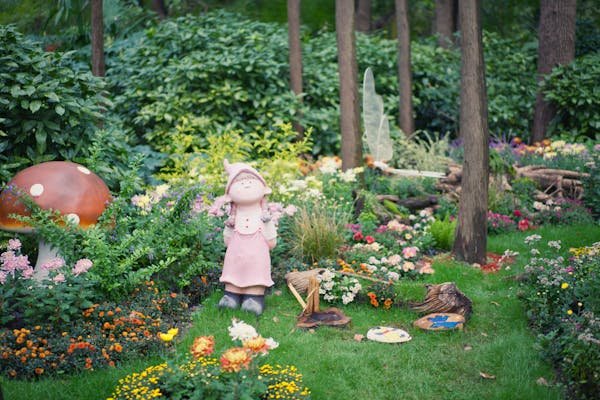Introduction
A fairy garden is a miniature, enchanted world that captures the whimsy and magic of folklore. These tiny landscapes, often filled with delicate plants, tiny houses, and miniature accessories, invite us to step into a realm where imagination blooms. Whether placed in a backyard, on a windowsill, or in a terrarium, fairy gardens bring a touch of fantasy to everyday life. They are not just decorative pieces but also a creative outlet that allows both children and adults to craft their own mystical stories. In this article, we’ll explore the enchanting elements of fairy gardens, from design inspiration to plant choices, and how you can create your very own pocket of magic.
1. The Origins and Allure of Fairy Gardens
Fairy gardens have roots in ancient folklore, where tales of tiny, mystical beings living among flowers and trees captivated cultures worldwide. From Celtic fairies to Japanese kodama, the idea of miniature creatures inhabiting hidden natural spaces has always sparked human imagination. Today, fairy gardens blend this age-old fascination with modern gardening trends, offering a whimsical way to connect with nature. Their charm lies in their ability to transform ordinary spaces into something extraordinary, making them a beloved hobby for gardeners and dreamers alike.
2. Choosing the Perfect Container for Your Fairy Garden
The foundation of any fairy garden is its container, which can range from rustic clay pots to glass terrariums or even repurposed household items like teacups and wooden crates. Outdoor fairy gardens thrive in larger planters or directly in the ground, while indoor versions often use shallow dishes or glass domes to create a contained magical world. The key is selecting a vessel that allows for proper drainage (if using live plants) and provides enough space for creativity. A well-chosen container not only enhances the aesthetic but also ensures your tiny ecosystem remains healthy and enchanting.
3. Selecting Plants for an Enchanted Landscape
The right plants bring a fairy garden to life, adding texture, color, and a sense of realism. Slow-growing, miniature plants like mosses, succulents, and dwarf ferns are ideal because they maintain their tiny proportions. Herbs such as thyme and creeping rosemary can mimic fairy-sized forests, while flowering plants like miniature violets or primroses add pops of color. For low-maintenance options, artificial plants or preserved moss can also be used, especially in closed terrariums. The goal is to create a lush, magical setting that feels alive and inviting to any wandering fairy.
4. Designing a Whimsical Fairy Garden Layout
A well-designed fairy garden tells a story, whether it’s a cozy cottage nestled among flowers or a mystical woodland with winding pebble paths. Start by planning the focal point—perhaps a tiny fairy house, a miniature bench, or a sparkling pond made from a mirror. Then, layer in elements like tiny fences, bridges, and stepping stones to add depth. Natural materials such as pebbles, twigs, and acorns enhance the organic feel, while tiny accessories like lanterns and fairy figurines bring personality. Balance is key; overcrowding can make the scene look chaotic, while too much empty space may feel unfinished.
5. DIY Fairy Garden Accessories and Decor
One of the most enjoyable aspects of creating a fairy garden is crafting or collecting tiny decorations. Handmade accessories, such as a popsicle-stick fence or a bottle-cap pond, add a personal touch. Craft stores offer miniature furniture, fairy figurines, and tiny animals to populate your garden. For a natural look, use dried flowers, pinecones, and seashells as decorative elements. Lighting can also play a magical role—tiny LED fairy lights or solar-powered lamps can make your garden glow at night, enhancing its enchanting atmosphere.
6. Maintaining Your Fairy Garden’s Magic
Like any garden, fairy gardens require care to stay vibrant. Regular watering (if using live plants), pruning overgrown foliage, and cleaning dust from accessories will keep the scene fresh. Outdoor fairy gardens may need protection from harsh weather, while indoor versions benefit from occasional misting to maintain humidity. Seasonal updates—such as adding tiny pumpkins in autumn or snow-dusted trees in winter—can keep the garden dynamic and engaging year-round. With a little attention, your fairy garden will remain a captivating escape for years to come.
Conclusion
A fairy garden is more than just a decorative project; it’s a doorway to imagination, a peaceful retreat, and a celebration of nature’s delicate beauty. Whether you’re crafting one for relaxation, storytelling, or simply to add a touch of magic to your home, the process is as rewarding as the result. By selecting the right plants, designing with creativity, and maintaining its charm, your fairy garden will become a cherished miniature paradise. So gather your supplies, let your imagination soar, and create a tiny world where fairies (and maybe a little wonder) can come to life.


